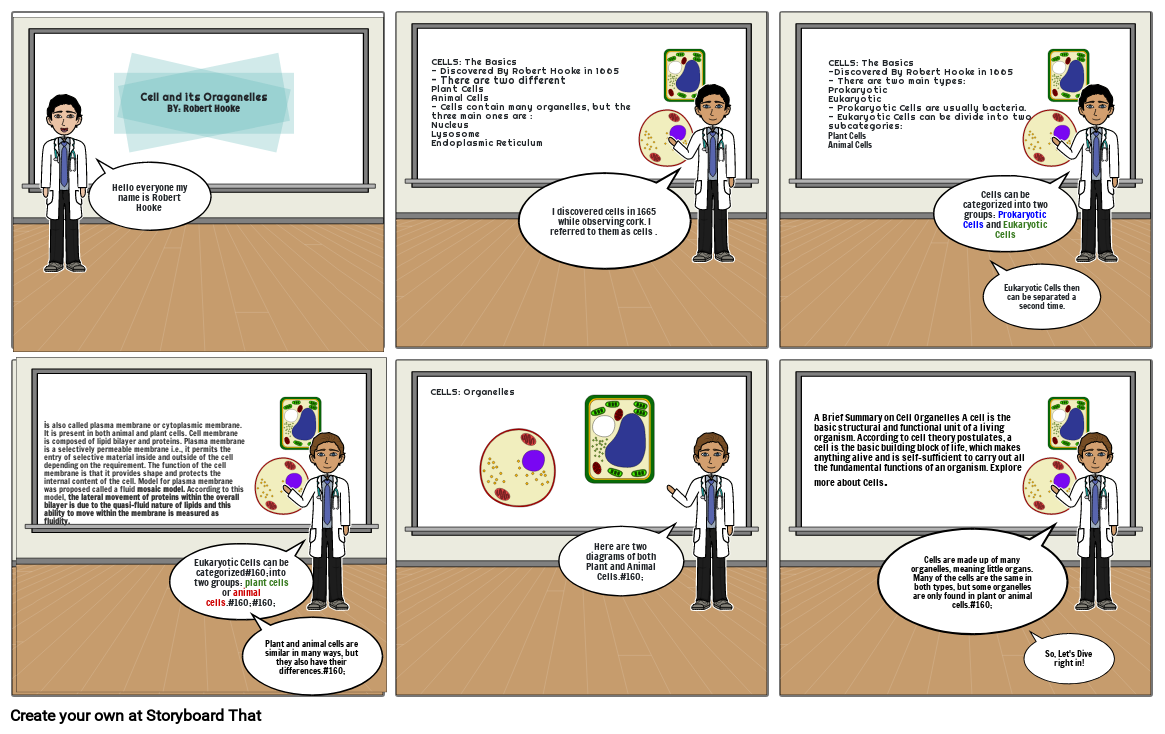Unknown Story

Storyboard Text
- Hello everyone my name is Robert Hooke
- Cell and its Oraganelles BY: Robert Hooke
- CELLS: Organelles
- CELLS: The Basics- Discovered By Robert Hooke in 1665- There are two differentPlant CellsAnimal Cells- Cells contain many organelles, but the three main ones are :Nucleus Lysosome Endoplasmic Reticulum
- I discovered cells in 1665 while observing cork. I referred to them as cells .
- CELLS: The Basics-Discovered By Robert Hooke in 1665- There are two main types: Prokaryotic Eukaryotic- Prokaryotic Cells are usually bacteria.- Eukaryotic Cells can be divide into two subcategories: Plant CellsAnimal Cells
- Cells can be categorized into two groups: Prokaryotic Cells and Eukaryotic Cells
- Eukaryotic Cells then can be separated a second time.
- is also called plasma membrane or cytoplasmic membrane. It is present in both animal and plant cells. Cell membrane is composed of lipid bilayer and proteins. Plasma membrane is a selectively permeable membrane i.e., it permits the entry of selective material inside and outside of the cell depending on the requirement. The function of the cell membrane is that it provides shape and protects the internal content of the cell. Model for plasma membrane was proposed called a fluid mosaic model. According to this model, the lateral movement of proteins within the overall bilayer is due to the quasi-fluid nature of lipids and this ability to move within the membrane is measured as fluidity.
- CELLS: The Basics- Discovered By Robert Hooke in 1665- There are two different#160;types:#160;#160; #160; 1) Plant Cells #160; #160;#160;2) Animal Cells#160;- Cells contain many organelles, but three are:#160;#160;#160;#160;#160;1) Nucleus #160; #160;#160;2) Lysosome #160;#160;#160;#160;3) Endoplasmic Reticulum#160;#160;
- Cells are made up of many organelles, meaning little organs. Many of the cells are the same in both types, but some organelles are only found in plant or animal cells.#160;
- Eukaryotic Cells can be categorized#160;into two groups: plant cells or animal cells.#160;#160;
- Plant and animal cells are similar in many ways, but they also have their differences.#160;
- CELLS: The Basics- Discovered By Robert Hooke in 1665- There are two different#160;types:#160;#160; #160; 1) Plant Cells #160; #160;#160;2) Animal Cells#160;- Cells contain many organelles, but three are:#160;#160;#160;#160;#160;1) Nucleus #160; #160;#160;2) Lysosome #160;#160;#160;#160;3) Endoplasmic Reticulum#160;#160;
- Indside of Cells there are many
- Here are two diagrams of both Plant and Animal Cells.#160;
- So, let's dive right in!
- A Brief Summary on Cell Organelles A cell is the basic structural and functional unit of a living organism. According to cell theory postulates, a cell is the basic building block of life, which makes anything alive and is self-sufficient to carry out all the fundamental functions of an organism. Explore more about Cells.
- CELLS: The Basics- Discovered By Robert Hooke in 1665- There are two different#160;types:#160;#160; #160; 1) Plant Cells #160; #160;#160;2) Animal Cells#160;- Cells contain many organelles, but three are:#160;#160;#160;#160;#160;1) Nucleus #160; #160;#160;2) Lysosome #160;#160;#160;#160;3) Endoplasmic Reticulum#160;#160;
- The first organelle we will cover is the nucleus.
- Indside of Cells there are many
- Cells are made up of many organelles, meaning little organs. Many of the cells are the same in both types, but some organelles are only found in plant or animal cells.#160;
- Nucleus
- So, Let's Dive right in!
- So, let's dive right in!
Over 30 Million Storyboards Created

